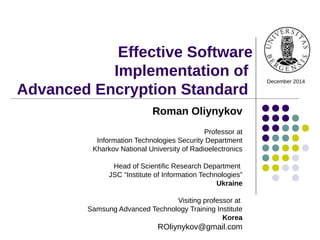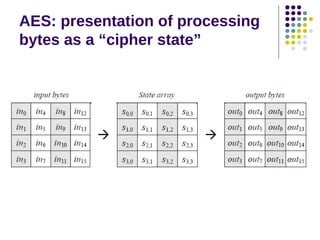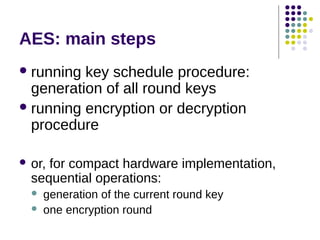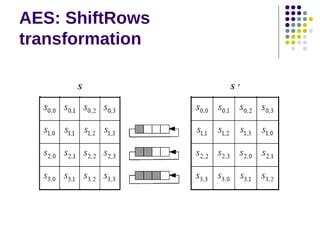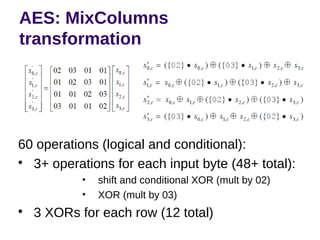AES effecitve software implementation
- 1. Effective Software Implementation of Advanced Encryption Standard December 2014 Roman Oliynykov Professor at Information Technologies Security Department Kharkov National University of Radioelectronics Head of Scientific Research Department JSC “Institute of Information Technologies” Ukraine Visiting professor at Samsung Advanced Technology Training Institute Korea [email protected]
- 2. Outline A few words about myself Brief history of AES/Rijndael AES properties Direct AES implementation and problems with it Methods for effective encryption implementation (proposed by Rijndael authors in their submission to AES competition) Decryption optimization Conclusions
- 3. About myself (I) I’m from Ukraine (Eastern part of Europe), host country of Euro2012 football championship I live in Kharkov (the second biggest city in the country, population is 1.5 million people), Eastern Ukraine (near Russia), former capital of the Soviet Ukraine (1918-1934) three Nobel prize winners worked at Kharkov University
- 4. About myself (II) Professor at Information Technologies Security Department at Kharkov National University of Radioelectronics courses on computer networks and operation system security, special mathematics for cryptographic applications Head of Scientific Research Department at JSC “Institute of Information Technologies” Scientific interests: symmetric cryptographic primitives synthesis and cryptanalysis Visiting professor at Samsung Advanced Technology Training Institute courses on computer networks and operation system security, software security, effective application and implementation of symmetric cryptography
- 5. Modern and effective solution: Advanced Encryption Standard (AES) result of international public cryptographic competition (1997-2000) had been chosen among 15 candidate ciphers (developed in the US, Belgium, Denmark, Germany, Israel, Japan, Switzerland, Armenia, etc.) original name is Rijndael (developed by researchers from Belgium) votes on 3rd AES conference had been given to this cipher, but the rest Twofish (US), MARS (US, IBM), E2 (Japan, Camellia predecessor), Serpent (Israel) are also remain strong the most researched block cipher all over the world (2014, open publications) basis for development of many other symmetric primitives
- 6. AES properties block length 128 bits only (subset of Rijndael which supports 128, 192 and 256 bits) key length is 128, 192 and 256 bits uses Substitution-Permutation Network (SPN) number of rounds (10,12,14) depends on key length quite transparent design, algebraic structure (theoretically may be vulnerable to algebraic analysis) quite effective in software (32-bit platforms) and hardware implementation
- 7. AES parameters: key length, block size, number of rounds
- 8. AES: presentation of processing bytes as a “cipher state”
- 9. AES: main steps running key schedule procedure: generation of all round keys running encryption or decryption procedure or, for compact hardware implementation, sequential operations: generation of the current round key one encryption round
- 11. AES: high-level structure (picture for 128 bit key)
- 16. AES round key generation (key expansion) NB: not all key length (128, 192, 256) must be supported; for many applications it’s enough to have the single key length
- 17. AES round key generation: RotWord
- 18. AES round key generation: SubBytes
- 19. AES round key generation: round constant application NB: without Rcon there would be equal blocks in ciphertext if plaintext and keys have equal blocks (1, 2 or 4 bytes repeats in plaintext and key)
- 20. AES round key sequence
- 21. AES decryption (direct presentation): reverse operations in different order
- 22. AES/Rijndael design goals be extremely fast on 32 bit platforms (+++) be compact on hardware implementation with small number of gates (++) possibility to implement cipher on 8-bit smart- card processors actual for 1990th (++) cryptographic strength (+)
- 23. Direct implementation of AES round function: SubBytes 16 operations (byte substitution)
- 24. Direct implementation of AES round function: ShiftRows 12 operations (byte permutation)
- 25. AES: MixColumns transformation 60 operations (logical and conditional): 3+ operations for each input byte (48+ total): • shift and conditional XOR (mult by 02) • XOR (mult by 03) 3 XORs for each row (12 total)
- 26. Direct implementation of AES round function SubBytes: 16 operations (byte substitution) ShiftRows: 12 operations (byte permutation) MixColumns: 60 or even more operations (conditions will prevent effective pipelining) AddRoundKey: 16 operations (logical) TOTAL: more than 102 operations per round
- 27. AES effective software implementation: 32-bit platform three different operations can be united into the single (!) look-up table access: SubBytes (non-linear) ShiftRows (linear) MixColumns (linear) cipher consists of look-up table accesses and round key additions
- 28. AES effective software implementation: MixColumns Matrix multiplication: 7 operations (4 memory look-ups + 3 XORs) instead of 60: 32-bit XOR of 4 columns each column depends on one input byte only all 4 bytes in each column are precomputed and stored in advance
- 29. AES round function operations sequence variants: Original: SubBytes ShiftRows MixColumns Equivalent: ShiftRows SubBytes MixColumns
- 30. AES effective software implementation: MixColumns and SubBytes at one precomputed table SubBytes and MixColumns: 7 operations (4 memory look-ups + 3 XORs) total: 32-bit XOR of 4 columns each column depends on one input byte only (already sent throw S-box) all 4 bytes in each column are precomputed and stored in advance
- 31. Fragment of OpenSSL AES source code (based on Rijndael author's implementation) 4 tables are needed; size of each table is 256 * 4 = 1 kByte
- 32. Fragment of OpenSSL AES source code (based on Rijndael author's implementation) ShiftRows is implemented as usual shift and mask of 32-bit register; SubBytes and MixColumns are implemented as memory lookups (8 bit → 32 bit)
- 33. AES effective software implementation: extra memory optimization Decreasing memory amount: single table (1 kByte instead of 4 tables of 1 kB each)
- 34. Main table size for the fastest and compact optimized 32-bit AES implementation fastest: (4 bytes) x (256 different entries to S-box) x x (4 different positions for ShiftRow) == 4 kbytes compact optimized: (4 bytes) x (256 different entries to S-box) == == 1 kbyte three additional operations in C ( << , >>, | or ^) are needed besides a table look-up NB: for reaching highest performance precomputed tables and processing data must fit into L1 processor cache (32-64kBytes for modern processors)
- 35. Number of 32-bit operations needed for a single block encryption at main transformation (having all round keys) ( (4 look-up) + (3 xors) ) * (4 columns) == == 28 operations / round 4 xors with round keys == == 4 operations / round (28 + 4) * (9 rounds) == 288 operations for high strength encryption of 9 rounds (!) (16 operations on SubBytes) + (24 operations on ShiftRows) + (4 xors with round keys) == == 44 operations at last round
- 36. AES decryption: high-level structure (pseudocode)
- 37. AES decryption: optimization SubBytes() and ShiftRows() transformations commute, their sequence can be chaged The column mixing operations - MixColumns() and InvMixColumns() – are linear with respect to the column input, which means InvMixColumns(state xor Round Key) == InvMixColumns(state) xor InvMixColumns(Round Key)
- 38. AES optimized decryption with changed round keys
- 39. Additional details on AES implementation two set of tables for encryption main optimized set (MixColumns, ShiftRows and SubBytes) separate S-box array for the last round two set of tables for decryption (complexity is the same as for encryption) main optimized set (InvMixColumns, InvShiftRows and InvSubBytes) separate reverse S-box array for the last round NB: ECB decryption is not needed for the most block cipher modes of operation
- 40. Conclusions direct AES implementation is very slow (requires many byte operations and conditions) three different round function operations can be united into the single look-up table access with effective implementation AES consists of look- up table accesses and round key additions the fastest version AES requires 4 kB of memory for tables, fast but compact requires 1 kB fast AES decryption operation has the same speed as encryption and uses changed order of round function operations with modified round keys

